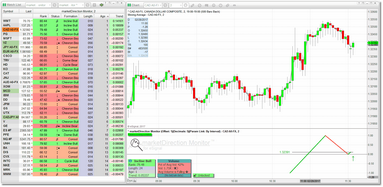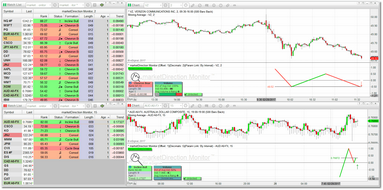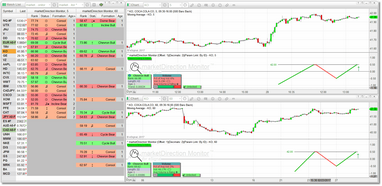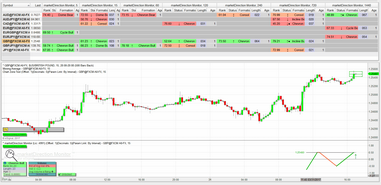
The Demo Pages
The easiest way to get up and running with marketDirection Monitor is make use of the example Demo pages that were included as part of the installation. The benefit to using one of the pages as your starting point is that the correct Time Template has already been attached to all of the components, the eSignal Symbol/Interval linking is already in place, and the eSignal Hibernation option has been turned off for all watchlists. You can pick the page that fits your particular needs the best and then customize it to make it your own.
Three example pages were included with the installation. See either the Watchlist Operation or the Chart Operation sections for step-by-step instructions on how to load one of these pages.
marketDirectionMonitorDemoPage1.page
This page consists of a single watchlist component linked to a single chart component. The marketDirection Monitor Time Template has been applied to both and the watchlist is linked to the chart by Symbol and by Interval. The params linking is set to 'Interval'. The default watchlist sort is the Age column in ascending order followed by the Rank column in descending order. If you have a basket of securities that you primarily want to monitor in only one bar interval (or you don't mind periodically changing the bar interval in the watchlist) then this is the page to use. Just replace our default list of symbols with your own and you should be ready to go.
marketDirectionMonitorDemoPage2.page
This page consists of two watchlist components linked to two chart components. The marketDirection Monitor Time Template has been applied to all components and each watchlist is linked to its own chart component by Symbol and by Interval. The params linking is set to "Interval" in both chart/watchlist combinations and each watchlist is running under a different bar interval (in this case, 2-min and 15-min but obviously you can select any intervals you care to use). The default watchlist sort is the Age column in ascending order followed by the Rank column in descending order. If you have enough screen real estate this configuration can be easily expanded to include additional watchlist/chart combos to support additional intervals. Just replace the symbol lists and you are ready to go.
marketDirectionMonitorDemoPage3.page
This page consists of one watchlist component linked to two chart components. The marketDirection Monitor Time Template has been applied to all components and the watchlist is linked to two separate charts by Symbol only. Two copies of marketDirection Monitor are running in the watchlist, the first running in the 5-min interval and the second running in the 60-min interval. The first copy of marketDirection Monitor is linked to the upper chart with params linking set to "ID", with an ID of 1 selected. The second copy of marketDirection Monitor in the watchlist is linked to the lower chart with params linking set to "ID", with an ID of 2 selected. Since only Symbol linking is being used you must set each chart manually to the correct bar interval, which is what we have done. The default watchlist sort is the Age column in ascending order followed by the Rank column in descending order. This configuration can be easily expanded to 3 copies running in the watchlist linked to 3 charts. Detecting formations in different bar intervals for the same symbol is a powerful approach and this is the configuration to use for that task.
This last layout is not one of the included pages, but we would be happy to send it to you if you would like to use it. This is a good example of how to make the most of marketDirection Monitor if you trade a smaller basket of securities and you monitor multiple intervals. In this case we have a handful of currency pairs and we are monitoring them on a total of 7 bar intervals in the watchlist, which is linked to a single chart. Whenever you click on a cell in the watchlist, the chart will change to that symbol as well as the bar interval associated with that particular cell. We have also minimized the title bars in both the watchlist and the chart to maximize screen real estate.
Multiple formations occurring in the same symbol in different bar intervals can be a very powerful signal and this particular layout makes that very easy to see. In this example we have Chevrons forming in the British Pound in the 15, 120, and 240-min intervals and a bullish Incline formation forming in the 720-min interval.
See Also:




